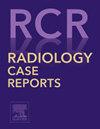Tolosa-Hunt syndrome presenting as persistent unilateral headache and painful ophthalmoplegia: A rare case report highlighting diagnostic challenges and therapeutic response
Q4 Medicine
引用次数: 0
Abstract
Tolosa-Hunt syndrome (THS) is a rare idiopathic granulomatous inflammation of the cavernous sinus, superior orbital fissure, or orbital apex, presenting with painful ophthalmoplegia. The exact etiology remains unclear, but it is believed to be immune-mediated. Early diagnosis is essential, as prompt corticosteroid therapy results in rapid symptom resolution. This case report highlights the clinical presentation, diagnostic workup, and management of a patient with Tolosa-Hunt syndrome, emphasizing the role of neuroimaging in confirming the diagnosis and the efficacy of corticosteroid treatment. A 55-year-old male presented with a persistent right-sided headache for 2.5 months, accompanied by diplopia for 5 days. Neurological and ophthalmic examination revealed right-sided ptosis, restricted extraocular movements, and binocular diplopia. MRI findings demonstrated an asymmetric enlargement of the right cavernous sinus with inflammatory changes extending into the orbital apex and superior orbital fissure, confirming Tolosa-Hunt syndrome. The patient was treated with high-dose corticosteroids, leading to significant clinical improvement. Following corticosteroid therapy, the patient experienced rapid resolution of headache and improvement in ocular motility. Repeat MRI after 6 weeks showed a marked reduction in inflammation. There was no recurrence of symptoms upon gradual steroid tapering. Tolosa-Hunt syndrome should be considered in patients with unilateral headache and painful ophthalmoplegia. MRI plays a crucial role in diagnosis, and corticosteroids remain the mainstay of treatment, leading to excellent outcomes. Early recognition and intervention can prevent long-term complications and disability.
Tolosa-Hunt综合征表现为持续性单侧头痛和疼痛性眼麻痹:罕见病例报告,突出诊断挑战和治疗反应
托洛萨-亨特综合征(THS)是一种罕见的海绵窦、眶上裂或眶尖的特发性肉芽肿性炎症,表现为疼痛性眼麻痹。确切的病因尚不清楚,但据信是免疫介导的。早期诊断是必要的,因为及时的皮质类固醇治疗可迅速缓解症状。本病例报告强调了Tolosa-Hunt综合征患者的临床表现、诊断检查和治疗,强调了神经影像学在确认诊断和皮质类固醇治疗效果中的作用。男,55岁,右侧头痛2.5个月,伴复视5天。神经及眼科检查显示右侧上睑下垂,眼外运动受限,双眼复视。MRI显示右侧海绵窦不对称扩大,炎性改变延伸至眶尖和眶上裂,证实Tolosa-Hunt综合征。患者接受大剂量皮质类固醇治疗,临床明显改善。经皮质类固醇治疗后,患者头痛迅速缓解,眼球运动改善。6周后复查MRI显示炎症明显减轻。在类固醇逐渐减量后没有症状复发。单侧头痛和疼痛性眼麻痹患者应考虑Tolosa-Hunt综合征。MRI在诊断中起着至关重要的作用,皮质类固醇仍然是治疗的主要手段,导致了良好的结果。早期识别和干预可以预防长期并发症和残疾。
本文章由计算机程序翻译,如有差异,请以英文原文为准。
求助全文
约1分钟内获得全文
求助全文
来源期刊

Radiology Case Reports
Medicine-Radiology, Nuclear Medicine and Imaging
CiteScore
1.10
自引率
0.00%
发文量
1074
审稿时长
30 days
期刊介绍:
The content of this journal is exclusively case reports that feature diagnostic imaging. Categories in which case reports can be placed include the musculoskeletal system, spine, central nervous system, head and neck, cardiovascular, chest, gastrointestinal, genitourinary, multisystem, pediatric, emergency, women''s imaging, oncologic, normal variants, medical devices, foreign bodies, interventional radiology, nuclear medicine, molecular imaging, ultrasonography, imaging artifacts, forensic, anthropological, and medical-legal. Articles must be well-documented and include a review of the appropriate literature.
 求助内容:
求助内容: 应助结果提醒方式:
应助结果提醒方式:


